英语演讲稿北极熊doc
北极熊的作文
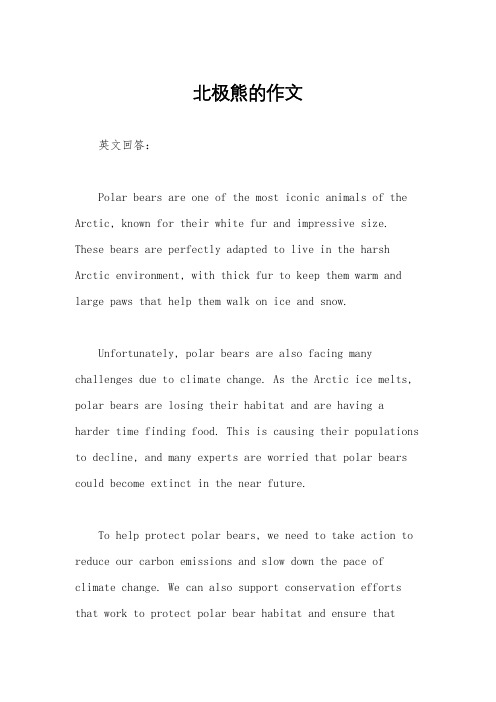
北极熊的作文英文回答:Polar bears are one of the most iconic animals of the Arctic, known for their white fur and impressive size. These bears are perfectly adapted to live in the harsh Arctic environment, with thick fur to keep them warm and large paws that help them walk on ice and snow.Unfortunately, polar bears are also facing many challenges due to climate change. As the Arctic ice melts, polar bears are losing their habitat and are having a harder time finding food. This is causing their populations to decline, and many experts are worried that polar bears could become extinct in the near future.To help protect polar bears, we need to take action to reduce our carbon emissions and slow down the pace of climate change. We can also support conservation efforts that work to protect polar bear habitat and ensure thatthese magnificent animals have the resources they need to survive.中文回答:北极熊是北极地区最具代表性的动物之一,以其白色的毛发和巨大的体型而闻名。
英语北极熊作文

英语北极熊作文北极熊是一种生活在北极地区的壮观动物,它们是极地生态系统的重要组成部分。
以下是关于英语北极熊的作文:Exploring the Majestic Polar BearIn the vast, icy expanse of the Arctic, roams one of nature's most magnificent creatures - the polar bear. With its thick, white fur and powerful build, the polar bear is perfectly adapted to thrive in the harsh conditions of its icy habitat.Polar bears are apex predators of the Arctic, ruling over the frozen landscape with grace and strength. Their keen sense of smell helps them locate seals, their primary prey, even from great distances. Patiently, they wait by sealbreathing holes or stalk them across the ice, demonstrating remarkable hunting skills honed over generations.But the polar bear's existence is intricately tied to the delicate balance of the Arctic ecosystem, a balance that is now under threat due to climate change. The rapid melting of sea ice, essential for polar bears to hunt and travel, has led to a decline in their populations. As their icy habitat dwindles, polar bears face challenges in finding food and raising their young.Conservation efforts are crucial to safeguard the future of these majestic creatures. From reducing carbon emissions to implementing policies that protect their habitat, there is much that can be done to mitigate the impacts of climate change on polar bears. Additionally, raising awareness aboutthe plight of polar bears can inspire individuals and governments to take action to preserve their icy home.In conclusion, the polar bear is not just a symbol of the Arctic; it is a symbol of our planet's fragile ecosystem. By working together to address the threats facing polar bears, we can ensure that future generations will continue to marvel at the sight of these magnificent creatures roaming the icy wilderness of the North.这篇作文介绍了北极熊的生活习性、面临的威胁以及保护工作的重要性。
介绍北极熊和呼吁保护北极熊英语作文
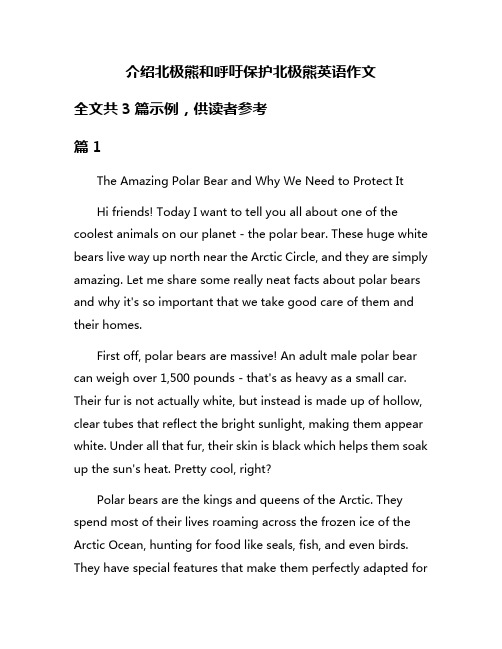
介绍北极熊和呼吁保护北极熊英语作文全文共3篇示例,供读者参考篇1The Amazing Polar Bear and Why We Need to Protect ItHi friends! Today I want to tell you all about one of the coolest animals on our planet - the polar bear. These huge white bears live way up north near the Arctic Circle, and they are simply amazing. Let me share some really neat facts about polar bears and why it's so important that we take good care of them and their homes.First off, polar bears are massive! An adult male polar bear can weigh over 1,500 pounds - that's as heavy as a small car. Their fur is not actually white, but instead is made up of hollow, clear tubes that reflect the bright sunlight, making them appear white. Under all that fur, their skin is black which helps them soak up the sun's heat. Pretty cool, right?Polar bears are the kings and queens of the Arctic. They spend most of their lives roaming across the frozen ice of the Arctic Ocean, hunting for food like seals, fish, and even birds. They have special features that make them perfectly adapted forlife in the freezing cold conditions up north. Their two layers of fur keep them insulated and their front paws have small bumps and rough surfaces to grip the slippery ice. They even have tiny clear eyelids that act like sunglasses and stop snow blindness!Polar bears are incredible hunters and swimmers too. They can smell seals 20 miles away and can run as fast as a horse for short bursts to catch their prey. When swimming, they use their front paws to propel themselves through frigid Arctic waters. Sometimes they have to swim over 60 miles across the ocean to get from one piece of ice to another! No wonder they are often called the "Marines of the Arctic."As you can probably tell, I really admire polar bears and think they are one of the most special creatures on Earth. But sadly, these magnificent animals are in danger and their populations are shrinking rapidly. Why is this happening? Mainly because of something called climate change.Climate change means the Earth is getting warmer due to gases like carbon dioxide being released into the atmosphere. As the planet warms up, the Arctic sea ice that polar bears depend on is melting at frightening speeds. Their icy hunting grounds are disappearing right beneath their feet!Without thick sea ice to live, hunt, breed, and den on, polar bears are having an extremely hard time surviving. Some bears are swimming much farther distances to find food or land, using up crucial energy and Body fat reserves. Smaller ice means mom bears have fewer places to dig dens and cubs are getting stranded when their dens collapse before they can walk. Many bears are struggling to find enough seals and other prey to eat.If climate change and sea ice melting continue at the current rate, it's estimated that two-thirds of polar bears could become extinct by the year 2050. That's just over 25 years from now! Can you imagine a world without these regal, beautiful Arctic giants?I don't want to live in a world without polar bears. And I'm sure you feel the same way. So what can we do to protect them? Well, the most important thing is to fight climate change by reducing our carbon footprint - the amount of greenhouse gases we release into the air.We can drive less, walk or ride bikes more often. We can turn off lights and electronics when not using them to conserve energy. We can recycle paper, plastic, glass and aluminum instead of throwing it away. We can plant trees which absorb carbon dioxide. And we can convince our parents to switch torenewable energy sources like solar or wind power instead of using fossil fuels.Every little action we take to reduce greenhouse gas emissions helps protect the Arctic sea ice that polar bears call home. We can also support organizations that work to conserve polar bear habitats and populations through donations or volunteering. Writing letters to government leaders to urge stronger climate policies is a great way to make your voice heard too.Polar bears are facing huge challenges as their world melts around them. But all of us, even kids, have the power to be part of the solution and give them a fighting chance at survival. Let's work together to keep these magnificent Arctic icons from disappearing forever. Polar bears are too amazing, important and special to lose. Don't you agree? Let's save the polar bears!篇2My Furry Friends, the Polar BearsHi everyone! Today I want to tell you all about one of my favorite animals - the polar bear. Polar bears are these huge, fluffy white bears that live in the Arctic regions near the NorthPole. They are so cute and cuddly looking, but also very strong and powerful hunters.Polar bears are marine mammals, which means they live in the sea. However, they spend a lot of their time on the sea ice in places like Canada, Greenland, Norway, and Russia. Their thick fur coats and a layer of fat called blubber underneath their skin helps keep them warm in the freezing Arctic temperatures.Even though polar bears look white, their fur is actually transparent! Each hollow hair actually helps scatter and reflect light, making the polar bear appear white. This helps camouflage or blend them into their snowy surroundings. Pretty neat, huh?Polar bears have some amazing adaptations that help them survive in the harsh Arctic environment. Their big feet act like snowshoes, spreading out their weight so they don't fall through the ice and snow. The rough pads on the bottom of their feet also provide traction on the slippery ice.Their long necks help them stick their heads in seal breathing holes in the ice to hunt. And those big paws? They use them like scoops to paddle through water when swimming! Speaking of swimming, polar bears are actually really great swimmers. They can swim over 60 miles without stopping if they need to!Now let me tell you about how they hunt for food. Polar bears are at the top of the Arctic food chain, which means they are elite predators with no natural enemies (besides humans). Their main prey is seals, especially ringed seals and bearded seals.Polar bears will patiently wait by a seal's breathing hole in the ice for a looong time, waiting for a seal to pop up for air. Then wham! They'll try to grab the seal with their powerful paws and jaws. It sounds intense, but this is just how they survive in their harsh habitat.When they aren't hunting seals, polar bears will also eat fish, eggs, reindeer, small rodents, and even dolphin carcasses if they come across any. These bears need to eat a LOT to build up enough fat reserves to survive the harsh Arctic winters.Since polar bears are such powerful predators, you'd think they don't have much to worry about, right? Well unfortunately, that's not the case. Climate change caused by human activities like burning fossil fuels is a huge threat to their survival.You see, as global temperatures rise, the sea ice that polar bears depend on for hunting and traveling is melting at alarming rates. With less stable sea ice, it becomes much harder for polarbears to hunt seals and travel between feeding areas. Many bears are becoming stranded with limited access to food.The loss of sea ice also means polar bear cubs have a harder time surviving. Mother bears need stable ice to build dens and nurse their cubs after giving birth through the winter. If the ice isn't thick enough, their dens can collapse, leaving the tiny cubs exposed to the freezing elements.Less sea ice also forces polar bears to swim longer distances to find food or habitat. While they are excellent swimmers, the farther they have to swim, the more energy they burn through their fat reserves. This leaves them in poor condition and less able to survive Arctic winters.Climate change is causing major problems for polar bear populations. Their total numbers have declined by around 40% over the last few decades. Some populations have declined as much as 90%! If we don't take action to slow climate change, it's estimated that we could lose up to 2/3 of polar bears by the year 2050. That's just so sad to think about.These beautiful creatures are in danger of going extinct because of human activities. We simply have to do something to protect them and their Arctic habitat! Even though I'm just a kid, there are things we all can do to help polar bears.First, we can reduce our carbon footprint by walking, biking, or taking public transportation instead of getting rides in cars or buses. We can also turn off lights and devices when not in use to save electricity. Planting trees is an easy way to absorb carbon dioxide too.At school, we can start recycling programs and do energy audits to find ways to make our buildings more energy efficient. We can also join environmental clubs or beach cleanup efforts. Every little bit helps!Polar bears are such fascinating creatures, and they play a vital role in the Arctic ecosystem. Just imagining a world without these regal bears roaming the sea ice breaks my heart. We simply cannot let climate change destroy their homes and food sources.As kids, we have to speak up and take action to protect polar bears and their habitat. We are the future caretakers of this planet after all. Let's be the generation that helps save these incredible animals before it's too late. Polar bears are counting on us!篇3The Amazing Polar BearsHi everyone! Today I want to tell you all about one of the coolest animals on our planet - the polar bear! Polar bears are these huge, white, fluffy bears that live in the Arctic, which is way up north near the North Pole. They are seriously awesome animals and I love learning about them.First of all, polar bears are massive! An adult male polar bear can weigh over 1,500 pounds, which is about the same as a small car. And they can grow to be over 10 feet long from their head to their rump. That's as tall as an adult giraffe standing on its head! With their thick fur and fat layers, polar bears bulk up to stay warm in the freezing Arctic temperatures that can drop to minus 40 degrees Fahrenheit. Brrrrr, no thanks! I'll stick to my cozy heated house.Despite their gigantic size, polar bears are actually incredible athletes and swimmers. They can swim for miles across icy waters chasing down seals, their favorite food. Seals make up the main part of a polar bear's diet. They use those huge paws to smash through ice and get to their prey. Polar bears rely on sea ice to hunt seals, which is why shrinking sea ice from global warming is such a big threat to them.Did you know polar bears are the largest land carnivores on Earth? It's true! They are super predators at the top of the Arcticfood chain. Thankfully for us humans, polar bears tend to avoid people and only get aggressive if they feel threatened or are protecting their cubs. Speaking of cubs, polar bear moms are amazing parents. They make dens in snow banks to give birth and nurse their babies during the long, dark Arctic winters. The cubs stay with their mothers for over two years until they are big enough to hunt and survive on their own.Polar bears live scattered across the icy Arctic regions of Canada, Greenland, Norway and Russia. They roam across the frozen tundra and pack ice hunting for food. Even though they look like adorably fluffy teddy bears, make no mistake - these guys are fierce killers! But please don't hold that against them - they are just doing what they need to survive in one of the harshest environments on our planet.Here's the sad part though - polar bear populations are shrinking rapidly due to global warming melting their icy habitats. In fact, scientists predict that if current warming trends continue, there could be no more polar bears in the wild by the year 2050! That would be absolutely devastating to lose these regal Arctic giants forever. The polar bears' sea ice is retreating at alarming rates due to our climate getting hotter from burning fossil fuels like gas and oil. Less ice means less seals for polarbears to hunt, and it also forces the bears to use up more energy trekking across open waters. Many polar bears are having to go without food for longer periods, which makes them lose weight and strength. The thinner the bear, the less chance it has to survive the harsh Arctic winter.So what can we do to help protect these amazing creatures? Well, the biggest thing is to fight climate change by reducing our carbon footprints. We all need to use less energy from fossil fuels and switch to cleaner renewable energy like solar and wind power. We can walk, bike or take public transportation more instead of driving. We can turn off lights when not in use and unplug devices to save electricity. And we can recycle, reuse and reduce waste to cut down on emissions from landfills. Every little bit helps in the battle against global warming.Another way to help polar bears is to donate money to conservation organizations like Polar Bears International that work to study and protect polar bear populations. They also raise awareness about polar bear challenges and promote sustainable environmental policies. With enough people getting involved and making changes, we can help save these incredible Arctic kings for generations to come.I sure hope this essay has made you appreciate how truly amazing polar bears are, while also understanding the grave threats they face. We have to work together to slow down global warming and preserve their habitats before it's too late. Polar bears are such an iconic symbol of the harsh yet beautiful Arctic tundra. Imagine how tragic it would be for our children and grandchildren to grow up on a planet without these regal beasts roaming the northern ice caps. Please join me in doing whatever we can to protect polar bears and their frosty kingdom. The Arctic world desperately needs its kings and queens!。
北极熊英文作文

北极熊英文作文【中英文实用版】Title: The Majestic Polar BearThe Arctic, a frigid and desolate land, is home to one of the most magnificent creatures on Earth - the polar bear. With their thick fur coats and powerful build, these creatures have captivated the hearts of many.标题:北极的神秘巨兽——北极熊北极,这片冰冷而荒凉的土地,孕育了地球上最令人惊叹的生物之一——北极熊。
它们那浓密的皮毛和强壮的身躯,吸引了无数人的目光。
As the largest land predators, polar bears are at the top of the food chain in the Arctic. They primarily feed on seals, using their strong jaws and sharp claws to catch and tear apart their prey.作为最大的陆生肉食动物,北极熊位于北极食物链的顶端。
它们主要以海豹为食,利用其强壮的下颚和锋利的爪子捕捉并撕碎猎物。
然而,这些看似威武的生物,却面临着日益严峻的生存挑战。
全球气候变化导致北极冰层融化,北极熊的栖息地正在迅速减少。
这一现象让人深感忧虑。
Despite their fearsome reputation, polar bears face a daunting challenge in their fight for survival. Global climate change has led to the rapid melting of Arctic ice, causing a significant reduction in their habitat. This alarming situation has raised concerns worldwide.To protect these iconic creatures, international efforts are being made to reduce carbon emissions and preserve the Arctic environment.It is crucial that we take action now to ensure the survival of the polar bear for future generations.为了保护这些标志性生物,国际社会正努力减少碳排放,保护北极环境。
英语演讲稿,北极熊
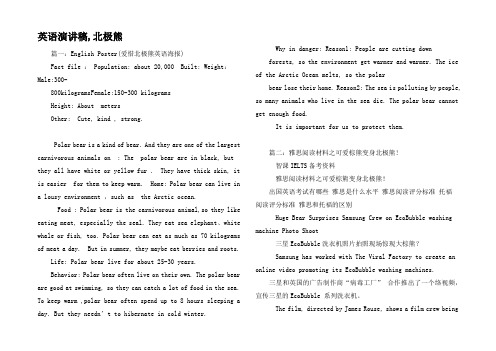
英语演讲稿,北极熊篇一:English Poster(爱惜北极熊英语海报)Fact file : Population: about 20,000 Built: Weight:Male:300-800kilogramsFemale:150-300 kilogramsHeight: About metersOther: Cute, kind , strong.Polar bear is a kind of bear. And they are one of the largest carnivorous animals on : The polar bear are in black, but they all have white or yellow fur . They have thick skin, it is easier for them to keep warm. Home: Polar bear can live in a lousy environment ,such as the Arctic ocean.Food : Polar bear is the carnivorous animal,so they like eating meat, especially the seal. They eat sea elephant、white whale or fish, too. Polar bear can eat as much as 70 kilograms of meat a day. But in summer, they maybe eat berries and roots.Life: Polar bear live for about 25-30 years.Behavior: Polar bear often live on their own. The polar bear are good at swimming, so they can catch a lot of food in the sea. To keep warm ,polar bear often spend up to 8 hours sleeping a day. But they needn’t to hibernate in cold winter.Why in danger: Reason1: People are cutting downforests, so the environment get warmer and warmer. The ice of the Arctic Ocean melts, so the polarbear lose their home. Reason2: The sea is polluting by people, so many animals who live in the sea die. The polar bear cannot get enough food.It is important for us to protect them.篇二:雅思阅读材料之可爱棕熊变身北极熊!智课IELTS备考资料雅思阅读材料之可爱棕熊变身北极熊!出国英语考试有哪些雅思是什么水平雅思阅读评分标准托福阅读评分标准雅思和托福的区别Huge Bear Surprises Samsung Crew on EcoBubble washing machine Photo Shoot三星EcoBubble洗衣机照片拍照现场惊现大棕熊?Samsung has worked with The Viral Factory to create an online video promoting its EcoBubble washing machines.三星和英国的广告制作商“病毒工厂”合作推出了一个络视频,宣传三星的EcoBubble 系列洗衣机。
介绍北极熊六年级英语作文
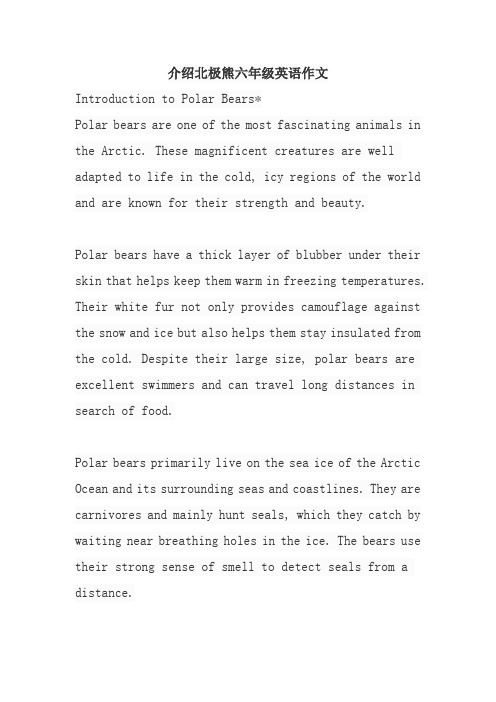
介绍北极熊六年级英语作文Introduction to Polar Bears*Polar bears are one of the most fascinating animals in the Arctic. These magnificent creatures are well adapted to life in the cold, icy regions of the world and are known for their strength and beauty.Polar bears have a thick layer of blubber under their skin that helps keep them warm in freezing temperatures. Their white fur not only provides camouflage against the snow and ice but also helps them stay insulated from the cold. Despite their large size, polar bears are excellent swimmers and can travel long distances in search of food.Polar bears primarily live on the sea ice of the Arctic Ocean and its surrounding seas and coastlines. They are carnivores and mainly hunt seals, which they catch by waiting near breathing holes in the ice. The bears use their strong sense of smell to detect seals from a distance.A polar bear's large paws are specially designed for swimming. Their paws are covered with small, rough pads that help them grip the ice and swim more efficiently. These bears are also known for their powerful claws, which they use for hunting and climbing on ice.Unfortunately, polar bears are facing significant threats due to climate change. The melting of sea ice due to rising temperatures is making it harder for them to find food and suitable habitats. As their environment changes, polar bears are forced to travel farther and expend more energy to find the resources they need to survive.Conservation efforts are crucial to help protect polar bears and their habitat. By addressing climate change and supporting Arctic preservation initiatives, we can contribute to the survival of these incredible animals.In summary, polar bears are remarkable animals that are perfectly adapted to their Arctic environment. However, they face serious challenges due to environmentalchanges, and it is our responsibility to help ensure their continued survival.。
保护北极熊演讲稿英文

保护北极熊演讲稿英文Ladies and gentlemen,。
Today, I stand before you to talk about the urgent need to protect the polar bear, also known as the Arctic bear. The polar bear is a symbol of the Arctic, a majestic and powerful creature that has become an icon of the environmental challenges we face today. However, due to the rapid changes in the Arctic environment, the polar bear population is facing a serious threat to its survival. It is our responsibility to take action and protect these magnificent animals before it's too late.First and foremost, the melting of the polar ice caps due to climate change is the biggest threat to the polar bear's habitat. As the ice melts, polar bears are losing their hunting grounds and are forced to travel longer distances to find food. This not only puts a strain on the bears' energy reserves, but it also increases the risk of human-bear conflicts as they come into contact with human settlements in search of food.Furthermore, the pollution of the Arctic environment is also a major concern for the polar bear population. Chemical pollutants such as PCBs and pesticides accumulate in the bodies of polar bears through the food chain, leading to reproductive and developmental problems. This not only affects the bears themselves, but also has a ripple effect on the entire Arctic ecosystem.In addition, the expansion of industrial activities in the Arctic, such as oil and gas exploration, poses a direct threat to the polar bear's habitat. As human activities encroach further into the Arctic, the bears are at risk of losing even more of their natural habitat, leading to further population declines.So, what can we do to protect the polar bear? First and foremost, we need to take decisive action to combat climate change. This means reducing our carbon emissions, investing in renewable energy sources, and advocating for policies that protect the Arctic environment. Additionally, we need to work towards reducing pollution in the Arctic and enforcing regulations that limit industrial activities in polar bear habitats.We also need to support conservation efforts and research initiatives aimed at better understanding the needs of polar bears and their ecosystems. By investing in scientific research and conservation programs, we can work towards ensuring a sustainable future for the polar bear population.In conclusion, the protection of the polar bear is not just a moral imperative, but also a crucial step in preserving the Arctic ecosystem as a whole. By addressing the root causes of the threats facing polar bears, we can work towards ensuring their survival for generations to come. It is up to us to take action and protect these magnificent creatures before it's too late.Thank you.。
英语演讲稿,北极熊
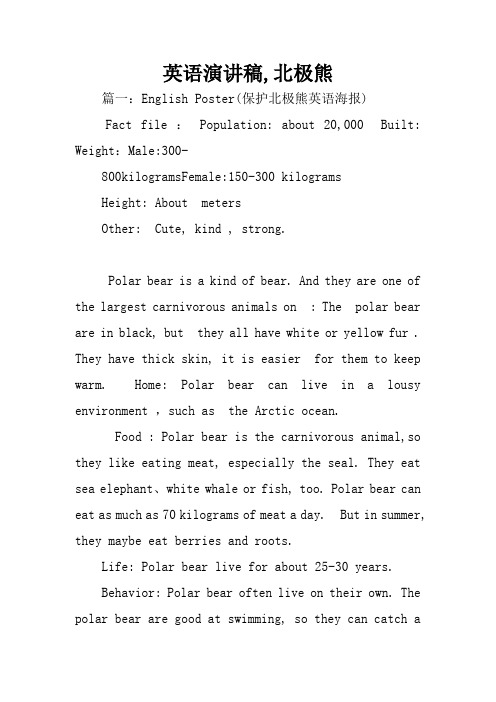
英语演讲稿,北极熊篇一:English Poster(保护北极熊英语海报)Fact file :Population: about 20,000 Built: Weight:Male:300-800kilogramsFemale:150-300 kilogramsHeight: About metersOther: Cute, kind , strong.Polar bear is a kind of bear. And they are one of the largest carnivorous animals on : The polar bear are in black, but they all have white or yellow fur . They have thick skin, it is easier for them to keep warm. Home: Polar bear can live in a lousy environment ,such as the Arctic ocean.Food : Polar bear is the carnivorous animal,so they like eating meat, especially the seal. They eat sea elephant、white whale or fish, too. Polar bear can eat as much as 70 kilograms of meat a day. But in summer, they maybe eat berries and roots.Life: Polar bear live for about 25-30 years.Behavior: Polar bear often live on their own. The polar bear are good at swimming, so they can catch alot of food in the sea. To keep warm ,polar bear often spend up to 8 hours sleeping a day. But they needn’t to hibernate in cold winter.Why in danger: Reason1: People are cutting down forests, so the environment get warmer and warmer. The ice of the Arctic Ocean melts, so the polar bear lose their home. Reason2: The sea is polluting by people, so many animals who live in the sea die. The polar bear cannot get enough food.It is important for us to protect them.篇二:雅思阅读材料之可爱棕熊变身北极熊!智课IELTS备考资料雅思阅读材料之可爱棕熊变身北极熊!出国英语考试有哪些雅思是什么水平雅思阅读评分标准托福阅读评分标准雅思和托福的区别Huge Bear Surprises Samsung Crew on EcoBubble washing machine Photo Shoot三星EcoBubble洗衣机照片拍摄现场惊现大棕熊?Samsung has worked with The Viral Factory to create an online video promoting its EcoBubble washingmachines.三星和英国的广告制作商“病毒工厂”合作推出了一个络视频,宣传三星的EcoBubble 系列洗衣机。
北极熊英语作文和翻译

北极熊英语作文和翻译标题,Polar Bear: King of the Arctic。
Polar bears, often referred to as the kings of the Arctic, are majestic creatures that inhabit the icy landscapes of the far north. With their thick white fur and impressive size, they are truly remarkable animals that capture the imagination of people around the world. In this essay, we will explore the fascinating world of polar bears and delve into their characteristics, habitat, behavior, and the challenges they face in their rapidly changing environment.Introduction to Polar Bears。
Polar bears, scientifically known as Ursus maritimus, are the largest land carnivores on Earth. They are superbly adapted to life in the Arctic, where they spend much of their time hunting for seals on sea ice. One of the most distinctive features of polar bears is their thick layer ofblubber, which provides insulation against the freezing temperatures of their habitat. Additionally, their whitefur helps them blend in with the snowy surroundings, making them highly effective hunters.Characteristics。
北极熊英语作文初一
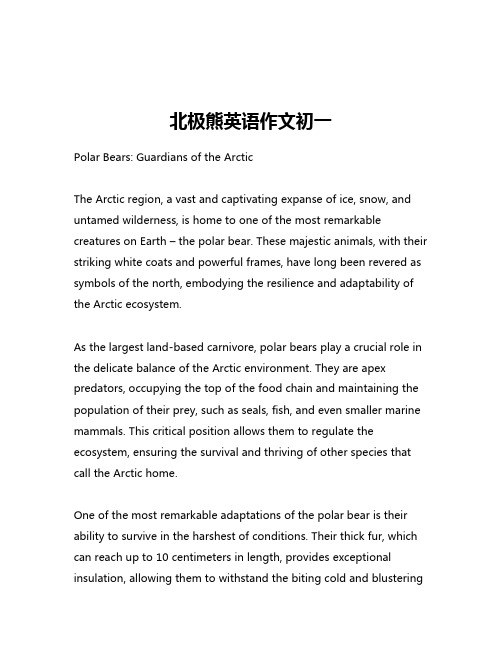
北极熊英语作文初一Polar Bears: Guardians of the ArcticThe Arctic region, a vast and captivating expanse of ice, snow, and untamed wilderness, is home to one of the most remarkable creatures on Earth – the polar bear. These majestic animals, with their striking white coats and powerful frames, have long been revered as symbols of the north, embodying the resilience and adaptability of the Arctic ecosystem.As the largest land-based carnivore, polar bears play a crucial role in the delicate balance of the Arctic environment. They are apex predators, occupying the top of the food chain and maintaining the population of their prey, such as seals, fish, and even smaller marine mammals. This critical position allows them to regulate the ecosystem, ensuring the survival and thriving of other species that call the Arctic home.One of the most remarkable adaptations of the polar bear is their ability to survive in the harshest of conditions. Their thick fur, which can reach up to 10 centimeters in length, provides exceptional insulation, allowing them to withstand the biting cold and blusteringwinds that sweep across the Arctic landscape. Their large paws, equipped with non-retractable claws, act as natural snowshoes, enabling them to move effortlessly across the frozen terrain.Polar bears are also renowned for their exceptional hunting skills. They possess a keen sense of smell, which they use to track their prey over vast distances. Their powerful jaws and sharp teeth allow them to crush the thick skulls of seals, their primary source of sustenance. Additionally, their ability to hold their breath for up to two minutes while hunting underwater gives them a distinct advantage in the icy waters of the Arctic.Despite their formidable strength and resilience, polar bears face a growing threat from the effects of climate change. As global temperatures rise and the Arctic ice melts at an alarming rate, the habitat and feeding grounds of these magnificent creatures are being severely disrupted. The loss of sea ice, which is essential for their hunting and breeding, has forced polar bears to venture further inland, often putting them in direct conflict with human settlements.The plight of the polar bear has become a global concern, with conservation efforts aimed at protecting this iconic species and the fragile Arctic ecosystem. Organizations such as the World Wildlife Fund (WWF) and the International Union for Conservation of Nature (IUCN) have been at the forefront of these efforts, working to raiseawareness, conduct research, and implement policies to safeguard the future of the polar bear.One of the most significant challenges in protecting the polar bear is the need for international cooperation and coordinated action. The Arctic region is shared by several countries, including the United States, Canada, Russia, Norway, and Greenland, each with its own set of environmental policies and priorities. Effective conservation efforts require these nations to come together, share resources, and develop comprehensive strategies to mitigate the impact of climate change on the Arctic ecosystem.Furthermore, the preservation of the polar bear is not just a matter of ecological importance; it also holds deep cultural and symbolic significance for the indigenous communities that have coexisted with these animals for centuries. The Inuit, Yupik, and other Arctic peoples have long revered the polar bear as a sacred and integral part of their way of life, and their traditional knowledge and stewardship of the land can provide invaluable insights for conservation efforts.In conclusion, the polar bear is a true icon of the Arctic, a living embodiment of the resilience and beauty of the northern wilderness. As we grapple with the pressing challenges of climate change, it is imperative that we recognize the vital role these magnificent creatures play in the delicate balance of the Arctic ecosystem andcommit to their protection. By working together, across borders and disciplines, we can ensure that the polar bear continues to roam the Arctic, inspiring wonder and awe in all who encounter them.。
写北极熊作文英文
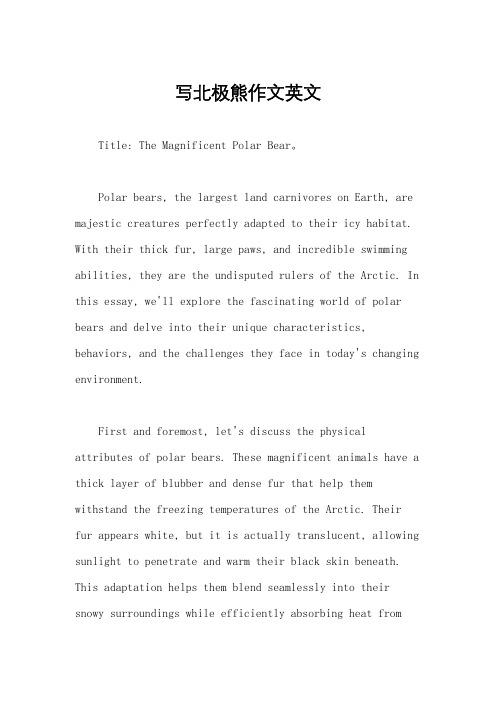
写北极熊作文英文Title: The Magnificent Polar Bear。
Polar bears, the largest land carnivores on Earth, are majestic creatures perfectly adapted to their icy habitat. With their thick fur, large paws, and incredible swimming abilities, they are the undisputed rulers of the Arctic. In this essay, we'll explore the fascinating world of polar bears and delve into their unique characteristics, behaviors, and the challenges they face in today's changing environment.First and foremost, let's discuss the physical attributes of polar bears. These magnificent animals have a thick layer of blubber and dense fur that help them withstand the freezing temperatures of the Arctic. Theirfur appears white, but it is actually translucent, allowing sunlight to penetrate and warm their black skin beneath. This adaptation helps them blend seamlessly into their snowy surroundings while efficiently absorbing heat fromthe sun.One of the most striking features of polar bears is their size. Adult males can weigh up to 1,500 pounds and measure over 10 feet in length, while females are slightly smaller, typically weighing between 500 to 700 pounds. Their massive size, coupled with powerful limbs and sharp claws, makes them formidable hunters.Speaking of hunting, polar bears are apex predators, primarily preying on seals. They rely on their keen sense of smell to detect seals' breathing holes in the ice from great distances. Once they locate a seal, polar bears use stealth and patience to approach their prey before launching a swift and powerful attack. Their hunting prowess is essential for their survival in the harsh Arctic environment, where food can be scarce.In addition to their hunting skills, polar bears are also excellent swimmers. They can cover long distances in search of food, swimming at an impressive speed of up to 6 miles per hour. Their partially webbed paws act likepaddles, propelling them through the icy waters with ease. This aquatic ability allows polar bears to access new hunting grounds and expand their range.Despite their formidable appearance and remarkable adaptations, polar bears face numerous threats, primarily due to climate change. As global temperatures rise, Arctic sea ice is melting at an alarming rate, reducing the polar bears' habitat and diminishing their hunting grounds. With less sea ice, polar bears have to travel greater distances to find food, leading to increased energy expenditure and decreased reproductive success.Furthermore, the decline in sea ice also brings polar bears into closer contact with humans, leading to conflicts and potential dangers for both parties. As theirtraditional hunting grounds disappear, polar bears may venture into human settlements in search of food, resulting in human-wildlife conflicts. Additionally, pollutants and contaminants from human activities pose a threat to polar bears' health and well-being, further exacerbating their challenges.In conclusion, polar bears are truly remarkable animals, perfectly adapted to thrive in the harsh conditions of the Arctic. However, they face unprecedented challenges due to climate change and human activities. It is imperative that we take action to mitigate these threats and preserve the Arctic habitat for future generations of polar bears. Through conservation efforts and collective action, we can ensure that these magnificent creatures continue to roamthe icy expanses of the North for years to come.。
北极熊,英文介绍小作文
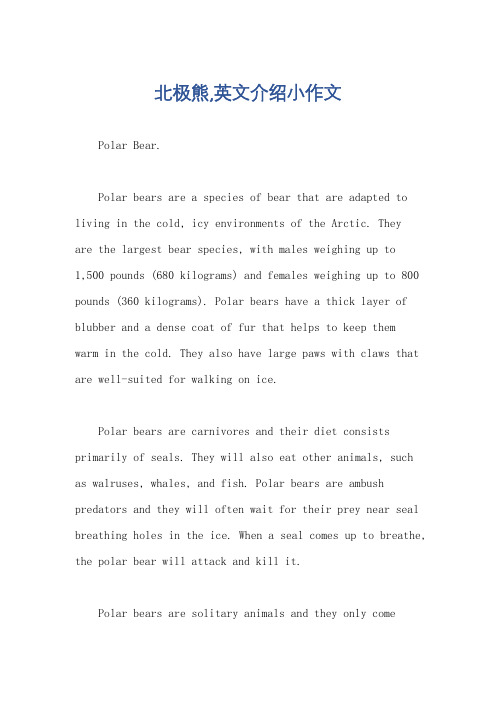
北极熊,英文介绍小作文Polar Bear.Polar bears are a species of bear that are adapted to living in the cold, icy environments of the Arctic. Theyare the largest bear species, with males weighing up to1,500 pounds (680 kilograms) and females weighing up to 800 pounds (360 kilograms). Polar bears have a thick layer of blubber and a dense coat of fur that helps to keep them warm in the cold. They also have large paws with claws that are well-suited for walking on ice.Polar bears are carnivores and their diet consists primarily of seals. They will also eat other animals, such as walruses, whales, and fish. Polar bears are ambush predators and they will often wait for their prey near seal breathing holes in the ice. When a seal comes up to breathe, the polar bear will attack and kill it.Polar bears are solitary animals and they only cometogether to mate. Females will give birth to one to three cubs in a snow den. The cubs will stay with their motherfor two years until they are old enough to hunt on their own.Polar bears are an important part of the Arctic ecosystem. They help to keep the seal population in check and they provide food for other animals, such as foxes and wolves.Threats to Polar Bears.Polar bears are facing a number of threats, including climate change, habitat loss, and pollution. Climate change is causing the Arctic sea ice to melt, which is reducing the amount of habitat available for polar bears. Habitat loss is also occurring due to the development of oil and gas fields in the Arctic. Pollution is another threat to polar bears, as they can ingest toxic chemicals from the environment.Conservation Efforts.There are a number of conservation efforts underway to help protect polar bears. These efforts include:Reducing greenhouse gas emissions to slow the pace of climate change.Protecting polar bear habitat from development.Reducing pollution in the Arctic.Educating the public about the importance of polar bears.Polar bears are an iconic species and they play an important role in the Arctic ecosystem. It is important to take action to protect these animals and ensure their survival for future generations.Additional Information.Polar bears are the only bears that live exclusivelyin the marine environment.Polar bears can swim for long distances and they have been known to travel up to 100 miles (160 kilometers) in a single day.Polar bears have a keen sense of smell and they can detect prey from miles away.Polar bears are intelligent animals and they have been known to use tools to help them hunt.Polar bears are a symbol of the Arctic and they are featured on the flags of several Arctic countries.。
关于北极熊英文作文
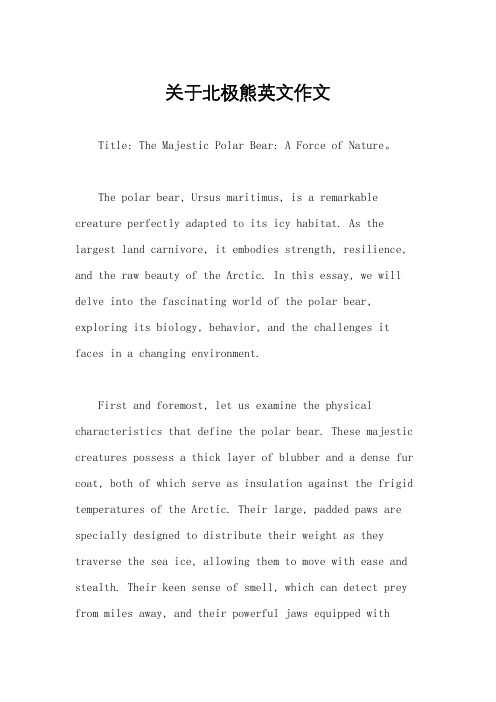
关于北极熊英文作文Title: The Majestic Polar Bear: A Force of Nature。
The polar bear, Ursus maritimus, is a remarkable creature perfectly adapted to its icy habitat. As the largest land carnivore, it embodies strength, resilience, and the raw beauty of the Arctic. In this essay, we will delve into the fascinating world of the polar bear, exploring its biology, behavior, and the challenges it faces in a changing environment.First and foremost, let us examine the physical characteristics that define the polar bear. These majestic creatures possess a thick layer of blubber and a dense fur coat, both of which serve as insulation against the frigid temperatures of the Arctic. Their large, padded paws are specially designed to distribute their weight as they traverse the sea ice, allowing them to move with ease and stealth. Their keen sense of smell, which can detect prey from miles away, and their powerful jaws equipped withsharp teeth make them apex predators in their ecosystem.Polar bears are solitary animals, typically roamingvast distances in search of food and mates. However, theydo congregate in significant numbers when a vital food source, such as a seal colony, is abundant. Despite their solitary nature, polar bears are not entirely antisocial. They communicate through various vocalizations, body language, and scent markings, especially during thebreeding season.The life cycle of a polar bear revolves around the annual freeze and thaw of the Arctic sea ice. They rely on the ice as a platform for hunting seals, their primary prey. During the winter months, polar bears embark on long journeys across the frozen expanses, hunting seals that surface through cracks in the ice to breathe. In the summer, when the ice recedes, polar bears are forced ashore,relying on fat reserves until the ice reforms.Unfortunately, the polar bear faces numerous threats to its survival, many of which are exacerbated by humanactivities. Climate change, in particular, poses a significant risk to polar bear populations. As the Arctic ice melts at an alarming rate, polar bears are losing crucial hunting grounds and struggling to find adequate food sources. The decline in sea ice also increases the likelihood of encounters with humans, leading to conflicts and disturbances.Furthermore, pollution and industrial activities in the Arctic region introduce additional challenges for polar bears. Contaminants such as persistent organic pollutants accumulate in the food chain, ultimately reaching high levels in polar bears, leading to reproductive problems and weakened immune systems. Oil and gas exploration also disrupts the fragile Arctic ecosystem, further threatening the survival of polar bears and other wildlife.Conservation efforts are crucial to ensuring the long-term survival of polar bears. Governments, conservation organizations, and local communities must work together to mitigate the impacts of climate change, reduce pollution, and protect critical habitats. Efforts to reduce carbonemissions, promote sustainable practices, and establish protected areas are essential steps in safeguarding the future of these iconic creatures.In conclusion, the polar bear is a symbol of the Arctic wilderness, embodying strength, resilience, and adaptability. However, it faces unprecedented challenges in a rapidly changing environment. By understanding the biology, behavior, and conservation needs of polar bears, we can take meaningful action to preserve their majestic presence in the icy realms of the North.。
介绍北极熊和呼吁保护北极熊英语作文
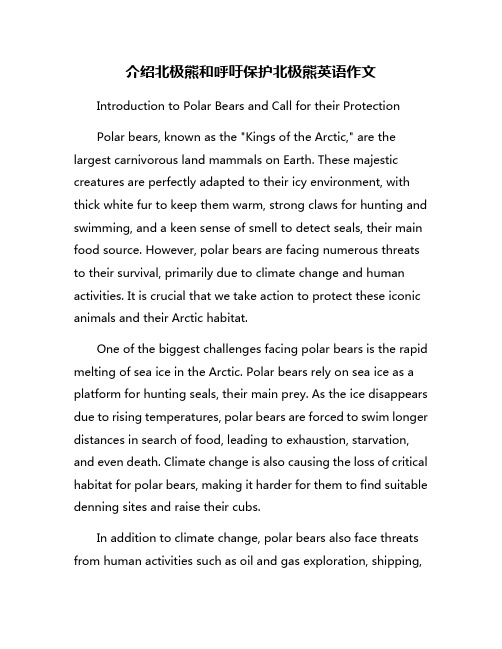
介绍北极熊和呼吁保护北极熊英语作文Introduction to Polar Bears and Call for their ProtectionPolar bears, known as the "Kings of the Arctic," are the largest carnivorous land mammals on Earth. These majestic creatures are perfectly adapted to their icy environment, with thick white fur to keep them warm, strong claws for hunting and swimming, and a keen sense of smell to detect seals, their main food source. However, polar bears are facing numerous threats to their survival, primarily due to climate change and human activities. It is crucial that we take action to protect these iconic animals and their Arctic habitat.One of the biggest challenges facing polar bears is the rapid melting of sea ice in the Arctic. Polar bears rely on sea ice as a platform for hunting seals, their main prey. As the ice disappears due to rising temperatures, polar bears are forced to swim longer distances in search of food, leading to exhaustion, starvation, and even death. Climate change is also causing the loss of critical habitat for polar bears, making it harder for them to find suitable denning sites and raise their cubs.In addition to climate change, polar bears also face threats from human activities such as oil and gas exploration, shipping,and hunting. Oil and gas drilling in the Arctic can lead to habitat destruction, pollution, and oil spills that harm polar bears and other wildlife. Increased shipping in the region can disturb polar bears and their habitats, as well as increase the risk of collisions with ships. Hunting of polar bears for their fur, meat, and body parts has also contributed to population declines in some areas.To protect polar bears and their Arctic habitat, it is essential that we take immediate action. One of the most important steps we can take is to reduce our carbon footprint and mitigate climate change. This includes transitioning to renewable energy sources, reducing greenhouse gas emissions, and supporting policies that protect the Arctic ecosystem. We must also work to reduce the impacts of human activities on polar bears, such as implementing regulations to limit oil and gas drilling, shipping, and hunting in the Arctic.Conservation efforts such as creating protected areas, monitoring polar bear populations, and conducting research on their behavior and habitat are also critical for their survival. Education and outreach efforts to raise awareness about the importance of polar bears and the threats they face can help inspire people to take action to protect them. By working together to address the challenges facing polar bears, we canensure that these magnificent animals continue to roam the Arctic for generations to come.In conclusion, polar bears are facing unprecedented challenges to their survival due to climate change and human activities. It is imperative that we take action to protect these iconic animals and their Arctic habitat before it is too late. By reducing our carbon footprint, minimizing the impacts of human activities, and supporting conservation efforts, we can help ensure a healthy future for polar bears and the entire Arctic ecosystem. Let us join together to safeguard the Kings of the Arctic and preserve their icy kingdom for future generations.。
介绍北极熊六年级英语作文
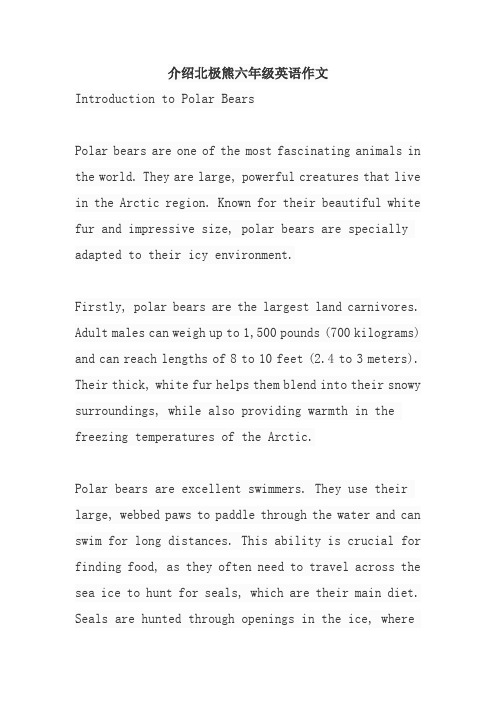
介绍北极熊六年级英语作文Introduction to Polar BearsPolar bears are one of the most fascinating animals in the world. They are large, powerful creatures that live in the Arctic region. Known for their beautiful white fur and impressive size, polar bears are specially adapted to their icy environment.Firstly, polar bears are the largest land carnivores. Adult males can weigh up to 1,500 pounds (700 kilograms) and can reach lengths of 8 to 10 feet (2.4 to 3 meters). Their thick, white fur helps them blend into their snowy surroundings, while also providing warmth in the freezing temperatures of the Arctic.Polar bears are excellent swimmers. They use their large, webbed paws to paddle through the water and can swim for long distances. This ability is crucial for finding food, as they often need to travel across the sea ice to hunt for seals, which are their main diet. Seals are hunted through openings in the ice, wherepolar bears use their strong sense of smell to locate them.One interesting fact about polar bears is that they are solitary animals. They usually live alone, except for mothers with their cubs. Female polar bears give birth to their cubs in dens made of snow and ice. These dens provide protection from the harsh weather and predators until the cubs are old enough to venture out with their mother.Sadly, polar bears are facing challenges due to climate change. As the Arctic ice melts because of rising temperatures, polar bears are losing their natural habitat and finding it more difficult to hunt for food. Conservation efforts are crucial to help protect these magnificent animals and their environment.In conclusion, polar bears are remarkable creatures adapted to life in the Arctic. Their strength, swimming ability, and unique behaviors make them an important symbol of the Arctic wilderness. Protecting them andtheir habitat is essential for ensuring their survival and the health of the Arctic ecosystem.。
有关北极熊的英语作文
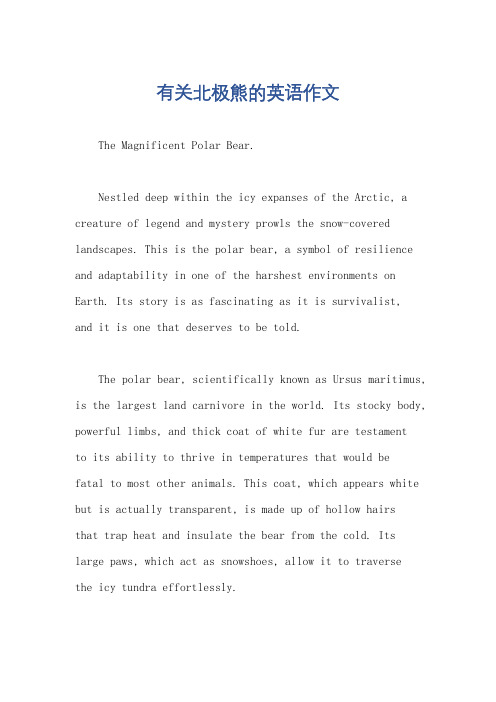
有关北极熊的英语作文The Magnificent Polar Bear.Nestled deep within the icy expanses of the Arctic, a creature of legend and mystery prowls the snow-covered landscapes. This is the polar bear, a symbol of resilience and adaptability in one of the harshest environments on Earth. Its story is as fascinating as it is survivalist,and it is one that deserves to be told.The polar bear, scientifically known as Ursus maritimus, is the largest land carnivore in the world. Its stocky body, powerful limbs, and thick coat of white fur are testamentto its ability to thrive in temperatures that would befatal to most other animals. This coat, which appears white but is actually transparent, is made up of hollow hairsthat trap heat and insulate the bear from the cold. Itslarge paws, which act as snowshoes, allow it to traversethe icy tundra effortlessly.The polar bear is a carnivore, preying primarily on seals. Its hunting skills are legendary, as it must stalk and ambush its prey in the vast, featureless snowscape. Its keen senses of smell and hearing are crucial to its survival, as visibility is often limited by the harsh weather conditions. Once a seal is caught, the polar bear uses its powerful jaws to tear it apart, consuming the meat raw.Despite its fierce reputation, the polar bear is also known for its gentle nature. They are often seen swimming and playing in the icy waters, seemingly unaware of their own powerful size and strength. These bears are also highly intelligent, and they display a range of complex behaviors, including tool use and social interaction.The polar bear's habitat, the Arctic, is a rapidly changing environment. Climate change has had a profound impact on this ecosystem, with sea ice – a crucial component of the polar bear's habitat – melting at unprecedented rates. This has had a devastating impact on the polar bear's food supply, forcing them to travel longerdistances and hunt in more challenging conditions.As a result of these changes, the polar bear's population has been declining. This is a conservationcrisis that demands urgent action. The international community has responded with measures such as the Polar Bear Conservation Act, which aims to protect and restore polar bear habitats. However, more needs to be done, and it is crucial that we all play our part in mitigating climate change and preserving this iconic species.In conclusion, the polar bear is a remarkable creature that has survived and adapted to the harshest of environments. Its story is one of resilience and survival, and it is a testament to the power of nature. However, its future is now in jeopardy, and it is up to us to ensurethat this magnificent beast can continue to roam the Arctic snowscapes for generations to come.The polar bear's survival is not just about the bear itself; it is about the health of the entire Arctic ecosystem. As top predators, they play a crucial role inmaintaining the balance of nature. Their decline would have ripple effects throughout the food chain, potentially leading to the collapse of the entire ecosystem.The fight to save the polar bear is also a fight for our own future. Climate change is a global issue that affects us all, and the choices we make today will determine the kind of world our children and grandchildren inherit. By taking action to reduce our carbon emissions, support sustainable practices, and protect wildlife habitats, we can ensure that the polar bear – and the Arctic it calls home – will be protected for generations to come.In the end, the polar bear's story is not just about survival; it is about hope. It is about the resilience of nature and the power of human compassion. It is a reminder that, in the face of insurmountable challenges, it is our collective responsibility to act, to ensure that the magnificence and wonder of the natural world is preserved for all time.The polar bear, with its white coat and powerful gait, remains a symbol of the Arctic, a region that is both beautiful and fragile. Its future is in our hands, and itis a responsibility that we cannot afford to ignore. Let us work together to ensure that the polar bear's story continues to be told, and that its legacy lives on in the hearts of all who come after us.。
英语有关保护北极熊的演讲稿范文
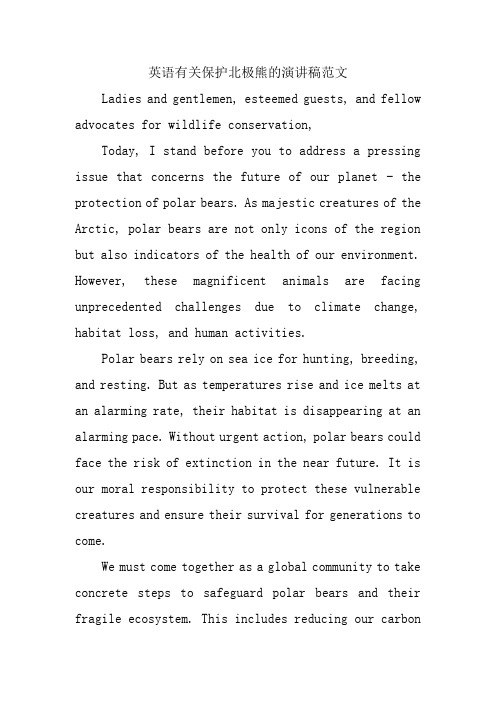
英语有关保护北极熊的演讲稿范文Ladies and gentlemen, esteemed guests, and fellow advocates for wildlife conservation,Today, I stand before you to address a pressing issue that concerns the future of our planet - the protection of polar bears. As majestic creatures of the Arctic, polar bears are not only icons of the region but also indicators of the health of our environment. However, these magnificent animals are facing unprecedented challenges due to climate change, habitat loss, and human activities.Polar bears rely on sea ice for hunting, breeding, and resting. But as temperatures rise and ice melts at an alarming rate, their habitat is disappearing at an alarming pace. Without urgent action, polar bears could face the risk of extinction in the near future. It is our moral responsibility to protect these vulnerable creatures and ensure their survival for generations to come.We must come together as a global community to take concrete steps to safeguard polar bears and their fragile ecosystem. This includes reducing our carbonfootprint, supporting sustainable practices, and advocating for policies that promote conservation efforts. By raising awareness, educating the public, and fostering partnerships, we can make a positive impact on the plight of polar bears and the Arctic environment.Let us remember that the fate of polar bears is intertwined with the well-being of our planet. By protecting them, we are also safeguarding the health of our oceans, the stability of our climate, and the diversity of our natural world. Together, we can make a difference and ensure a future where polar bears thrive in their icy home.In closing, I urge each and every one of you to join hands in this critical mission. Let us stand united in our commitment to protect polar bears and preserve the beauty of our world for future generations. Together, we can be the voice for the voiceless and the guardians of these magnificent creatures.Thank you.中文翻译:女士们、先生们,尊敬的嘉宾们,以及关心野生动物保护的同仁们,今天,我站在这里向大家呼吁一个关乎地球未来的紧迫问题,那就是保护北极熊。
英语作文北极熊
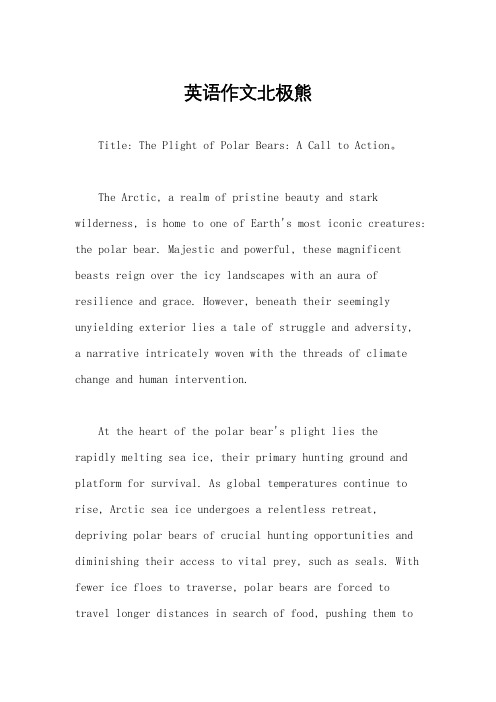
英语作文北极熊Title: The Plight of Polar Bears: A Call to Action。
The Arctic, a realm of pristine beauty and stark wilderness, is home to one of Earth's most iconic creatures: the polar bear. Majestic and powerful, these magnificent beasts reign over the icy landscapes with an aura of resilience and grace. However, beneath their seemingly unyielding exterior lies a tale of struggle and adversity,a narrative intricately woven with the threads of climate change and human intervention.At the heart of the polar bear's plight lies therapidly melting sea ice, their primary hunting ground and platform for survival. As global temperatures continue to rise, Arctic sea ice undergoes a relentless retreat, depriving polar bears of crucial hunting opportunities and diminishing their access to vital prey, such as seals. With fewer ice floes to traverse, polar bears are forced totravel longer distances in search of food, pushing them tothe brink of exhaustion and starvation.Moreover, the melting ice not only disrupts the polar bear's hunting patterns but also encroaches upon their natural habitat, leading to increased competition for resources and territorial disputes. As their icy realm dwindles, polar bears are left with no choice but toventure onto land in search of sustenance, bringing theminto closer proximity to human settlements and exposingthem to new threats and dangers.Human activities further exacerbate the challengesfaced by polar bears. Pollution, particularly plastic waste and oil spills, contaminates their environment and poses a grave risk to their health and well-being. Additionally, overfishing depletes the stocks of prey species vital tothe polar bear's diet, further exacerbating their struggle for survival.Despite these formidable challenges, hope remains onthe horizon. Conservation efforts, aimed at mitigating the impact of climate change and protecting polar bear habitats,offer a glimmer of optimism in an otherwise bleak landscape. International agreements and initiatives, such as the Paris Agreement, seek to address the root causes of climate change and promote sustainable practices to safeguard the Arctic ecosystem.Furthermore, raising awareness about the plight ofpolar bears is paramount in garnering support for conservation efforts. Education campaigns, outreach programs, and advocacy initiatives play a crucial role in highlighting the interconnectedness of all life forms and the importance of preserving biodiversity for future generations.Individual actions can also make a meaningfuldifference in the fight to save polar bears and their habitat. Simple lifestyle changes, such as reducing energy consumption, minimizing waste, and supporting eco-friendly initiatives, contribute to collective efforts to combat climate change and protect vulnerable species.In conclusion, the fate of the polar bear stands as apoignant reminder of the profound impact of humanactivities on the natural world. Yet, it also serves as a rallying cry for action, a call to arms to unite in defense of our planet and all its inhabitants. Together, we have the power to shape a future where polar bears roam freely amidst pristine Arctic landscapes, a future where the beauty and wonder of the natural world endure for generations to come.。
英语有关保护北极熊的演讲稿范文

英语有关保护北极熊的演讲稿范文全文共3篇示例,供读者参考篇1Ladies and gentlemen, esteemed guests, and fellow nature enthusiasts,Today, I stand before you to shed light on the importance of protecting the polar bear, one of the most majestic and iconic species of the Arctic. As we all know, the Arctic region is experiencing rapid environmental changes due to climate change, and the polar bear is facing unprecedented challenges to its survival. Without immediate and concerted efforts to protect this vulnerable species, we risk losing a valuable part of our planet's biodiversity.The polar bear, or Ursus maritimus, is uniquely adapted to the harsh conditions of the Arctic, with its thick layer of insulating fur, large paws for walking on ice, and powerful swimming abilities. They are also at the top of the Arctic food chain, playing a crucial role in maintaining ecosystem balance. However, with the melting of sea ice and the loss of their natural habitat, polar bears are finding it increasingly difficult to hunt for their primaryfood source – seals. This has resulted in a decline in their population numbers, with some estimates predicting a significant decrease in the coming years.To ensure the survival of the polar bear, we must take urgent action to address the root causes of their decline. This means reducing greenhouse gas emissions, which are responsible for the warming of the Arctic and the melting of sea ice. It also means implementing conservation measures to protect critical polar bear habitats and reduce human-wildlife conflicts. By working together to address these issues, we can make a real difference in the future of this magnificent species.One of the key ways to protect polar bears is through education and awareness-raising. By sharing knowledge about the importance of polar bears and the threats they face, we can inspire individuals and communities to take action to protect them. This can be done through school programs, public outreach campaigns, and partnerships with local communities in the Arctic region.Another important aspect of polar bear conservation is research and monitoring. By studying polar bear behavior, population trends, and habitat use, we can better understand their needs and develop effective strategies for their protection.This research can also help inform policy decisions and conservation efforts at the local, national, and international levels.In conclusion, the polar bear is a symbol of the Arctic and a barometer of the health of our planet. By taking action to protect this iconic species, we are not only preserving a vital part of our natural heritage but also safeguarding the future of our planet for generations to come. I urge each and every one of you to join me in this important cause and stand together in solidarity with the polar bear.Thank you for your attention. Let us work together to protect the polar bear and ensure a sustainable future for all life on Earth.篇2Ladies and gentlemen,Today I stand before you to talk about an important issue that is close to my heart – the protection of polar bears. These majestic creatures are facing numerous threats to their survival, and it is our responsibility to take action to ensure their future.Polar bears are iconic symbols of the Arctic, but they are increasingly at risk due to climate change. The melting of sea icehas significantly reduced their habitat and hunting grounds, making it difficult for them to find food and survive. In addition, pollution and human encroachment on their territory further threaten their well-being.As global citizens, we must come together to protect polar bears and the fragile environment they call home. One way we can do this is by supporting organizations and initiatives that are working to conserve their habitat and raise awareness about the challenges they face. We can also make personal choices that reduce our carbon footprint and help combat climate change, such as using public transportation, conserving energy, and supporting renewable energy sources.Furthermore, we must urge policymakers and governments to take decisive action to address the root causes of climate change and protect the Arctic ecosystem. By advocating for stronger environmental regulations and promoting sustainable practices, we can help ensure a brighter future for polar bears and other vulnerable species.In conclusion, the time to act is now. We cannot afford to stand idly by as polar bears face extinction. Together, we have the power to make a difference and protect these magnificent animals for generations to come. Let us work together to ensurea sustainable future for polar bears and preserve the beauty of the Arctic for all to enjoy.Thank you.篇3Ladies and gentlemen,I am honored to be standing before you today to discuss the important issue of protecting the Arctic polar bears. The Arctic polar bear is an iconic species that has come to symbolize the beauty and resilience of the Arctic environment. However, these majestic creatures are facing unprecedented threats to their survival due to climate change and other human-induced factors.The Arctic polar bear is a keystone species in the Arctic ecosystem. They play a critical role in maintaining the balance of the food chain in the region. As top predators, polar bears help regulate the populations of their prey species, such as seals and fish. By protecting the polar bear population, we are also protecting the entire Arctic ecosystem.Unfortunately, the Arctic polar bear is facing numerous challenges that are putting their population at risk. Climate change is the biggest threat to polar bears, as it is causing theArctic sea ice to melt at an alarming rate. Polar bears rely on sea ice as a platform to hunt for seals, their primary food source. With the sea ice disappearing, polar bears are having a harder time finding food, leading to malnutrition and decreased reproduction rates.In addition to climate change, other human-induced factors are also contributing to the decline of the Arctic polar bear population. Pollution, oil and gas exploration, and unsustainable hunting practices are all putting additional pressure on these already vulnerable animals. If we do not take immediate action to address these threats, we risk losing the Arctic polar bear forever.So, what can we do to protect the Arctic polar bear? The first step is to reduce our carbon footprint and take action to mitigate the effects of climate change. This includes reducing our greenhouse gas emissions, transitioning to renewable energy sources, and supporting conservation efforts to protect the Arctic habitat.We also need to address other human-induced factors that are impacting the Arctic polar bear population. This includes enacting laws and regulations to protect polar bears from hunting and other forms of exploitation, as well as enforcingstrict pollution controls to prevent further degradation of their habitat.Furthermore, we must support scientific research and monitoring programs to better understand the needs and behavior of polar bears. By studying these animals, we can develop effective conservation strategies to ensure theirlong-term survival.In conclusion, the Arctic polar bear is a vital part of the Arctic ecosystem and deserves our full protection and support. By working together to address the threats facing these majestic creatures, we can ensure that future generations will be able to enjoy the beauty and wonder of the Arctic polar bear. Thank you.。
北极熊 英文作文
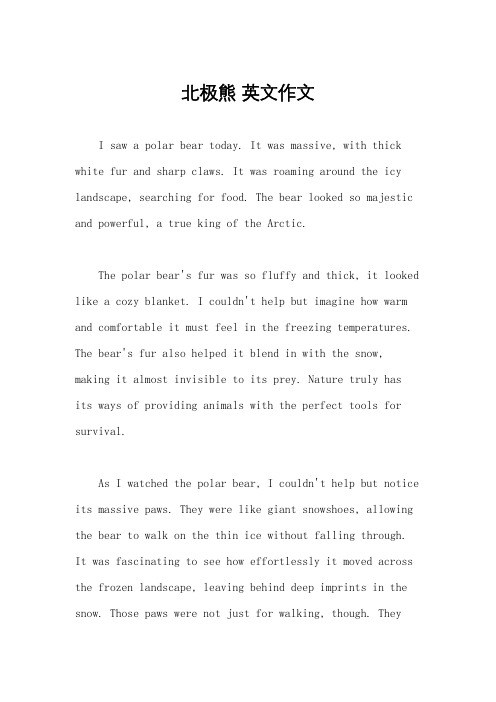
北极熊英文作文I saw a polar bear today. It was massive, with thick white fur and sharp claws. It was roaming around the icy landscape, searching for food. The bear looked so majestic and powerful, a true king of the Arctic.The polar bear's fur was so fluffy and thick, it looked like a cozy blanket. I couldn't help but imagine how warm and comfortable it must feel in the freezing temperatures. The bear's fur also helped it blend in with the snow, making it almost invisible to its prey. Nature truly hasits ways of providing animals with the perfect tools for survival.As I watched the polar bear, I couldn't help but notice its massive paws. They were like giant snowshoes, allowing the bear to walk on the thin ice without falling through. It was fascinating to see how effortlessly it moved across the frozen landscape, leaving behind deep imprints in the snow. Those paws were not just for walking, though. Theywere also deadly weapons, capable of delivering a powerful swipe to any potential threat.The polar bear's diet mainly consists of seals, whichit hunts by patiently waiting near their breathing holes in the ice. Once a seal comes up for air, the bear pounces with lightning speed, using its sharp teeth and strong jaws to make a kill. It's a brutal and primal sight to witness, reminding me that in the wild, it's all about survival of the fittest.Despite their fierce reputation, polar bears are also known for their nurturing side. The mother bear takes great care of her cubs, teaching them how to hunt and survive in the harsh Arctic environment. It's heartwarming to see the bond between a mother bear and her cubs, reminding us that even in the harshest of conditions, love and family are important.The polar bear's habitat is under threat due to climate change. The melting of the Arctic ice is reducing their hunting grounds and making it harder for them to find food.This is a grave concern, as polar bears are not only a symbol of the Arctic but also an important part of the ecosystem. It's a reminder that we need to take urgent action to protect our planet and the magnificent creatures that call it home.In conclusion, encountering a polar bear in the wild is a truly awe-inspiring experience. From its majestic appearance to its powerful hunting skills, the polar bearis a true symbol of the Arctic wilderness. However, it's also a reminder of the challenges that these magnificent creatures face due to climate change. We must do our part to ensure their survival and protect their habitat for future generations.。
- 1、下载文档前请自行甄别文档内容的完整性,平台不提供额外的编辑、内容补充、找答案等附加服务。
- 2、"仅部分预览"的文档,不可在线预览部分如存在完整性等问题,可反馈申请退款(可完整预览的文档不适用该条件!)。
- 3、如文档侵犯您的权益,请联系客服反馈,我们会尽快为您处理(人工客服工作时间:9:00-18:30)。
英语演讲稿北极熊篇一:雅思阅读材料之北极熊观察员智课网IELTS备考资料雅思阅读材料之北极熊观察员出国英语考试有哪些雅思6.5是什么水平雅思阅读评分标准托福阅读评分标准雅思和托福的区别Xu lives at the foot of Moon Mountain, a must-see tourist attraction in Yangshuo, where she has guided countless tourists. Her sincerity has won her the name "Mama Moon."徐秀珍住在月亮山脚下,这是阳朔的一个必去的旅游景点。
徐秀珍在那儿带过无数游客,亲切的她被游客们称为“月亮妈妈”。
Yangshuo, known for its other-worldly karst landscape and the Lijiang River, has been drawing millions of foreign tourists since China opened its door to international travelers in the early 1980s.阳朔超凡脱俗的喀斯特地貌景观和漓江使其声名远扬,自从中国在80年代早期向国际游客开放后,它吸引了数以百万计的外国游客。
The scenic town is home to many people who make a living by both farming and working as tour guides.这个风景优美的小镇的居民,多依靠农牧业和为游客做导游为生。
Over the past 16 years, Xu has taught herself 11 foreign languages, including English, Spanish, Japanese and Korean. In addition to making her incredibly popular, her linguistic prowess has made it easier for her to communicate with foreign tourists.在过去的16年中,徐秀珍自学了11门外语,包括英语,西班牙语,日语和韩语等。
这个会说多种语言的技能不但让她十分出名,更让她与外国游客交流起来更便利。
"My peers are trying to pick up new languages to boost their business, but no one can catch up with me," she said.徐秀珍说:“我的一些同行也想多学一些语言来促进自己的生意,但没有人能赶得上我。
”But the polyglot farmer's success has been hard-won. She started learning simple English phrases 16 years ago, when Yangshuo's tourism industry started to boom.但这位会说数国语言的农妇的成功得来不易,早在16年前,也就是阳朔的旅游业刚开始起步时,她就开始学习一些基础英语。
Illiterate, she was unable to read grammar books, so she had to memorize each word by its sound. But Xu seized every opportunity to talk to foreign tourists and tried to utter out her English.因为之前目不识丁,她并不能通过阅读语法书来学习英语,所以她必须通过读音来记忆每一个单词。
但是徐秀珍抓住每个能与外国游客说话的机会,去说一些她学到的英语。
Constant communication and a sense of perseverance proved effective, and she was gradually able to express herself in English. The determined woman has since learned other foreign languages in succession.频繁的交流和毅力终于收到了回报,她渐渐地开始能用英语表达自己,这个坚持到底的农妇自此之后又接连学会了其它多种语言。
With her command of 11 foreign languages, Xu is one of the busiest tour guides in Yangshuo. Her reputation draws a large crowd of tourists every day, especially foreign visitors, who come to meet the multilingual guide out of admiration.掌握了11门外语,徐秀珍成了阳朔最繁忙的导游,她的名声也为她每天都招揽了一大批游客,特别是一些对她敬仰已久特地来找她的外国游客。
"More and more foreign tourists are coming to Yangshuo, and I hope they will feel at home here with my help," she said.她说:“越来越多的外国游客来到阳朔,我希望通过我的帮助,他们都能把这儿当成自己家一样。
”Not content to simply serve as a tour guide, she now owns a popular restaurant and operates a reputable hotel.不满足于仅仅做一位导游,徐秀珍现在还开了一家受欢迎的餐馆以及一家好名声的旅馆。
Huang Yongzhong, director of Yangshuo's tourism bureau, said Xu's success has encouraged many farmers to follow suit.阳朔旅游局局长黄永忠说,徐秀珍的成功鼓励了许多农民也开始追随仿效她。
Official statistics show that 1.5 million foreign tourists visited Yangshuo in XX, a number that has inspired local tour guides to jump on the foreign language bandwagon with hopes of achieving success on par with that of "Mama Moon."官方数据显示XX年有150万外国游客来阳朔旅游,这个数字激励了许多当地导游去学习外语,希望能取得和“月亮妈妈”同样的成功。
"What 'Mama Moon' does is a good interpretation of the Yangshuo farmers' shared Chinese dream -- to make life better by learning new skills," Huang said.黄永忠称:“月亮妈妈的行为代表了阳朔农民的中国梦——通过学习新的技能来让自己的生活变得更好。
”He added that the government supports local tour guides by providing frequent training on the laws and regulations of the tourism industry.他补充道,政府会通过提供频繁的旅游业法规培训来支持当地导游。
Farmers in Yangshuo are passionate, sincere and hard-working, and this spirit will lead to more success stories like that of "Mama Moon," he said.他还说:“阳朔的农民热情、亲切并努力,正是这种精神将会带来诸如月亮妈妈那样的更多的成功故事。
”篇二:Unit 7单元整理及语言模块训练Unit 7单元整理及语言模块训练一、词汇归类1.重点单词:名词:square, meter, desert, population, Asia,tour, tourist, wall, ancient, achievement,condition, challenge, force, nature, ocean, birth, adult, bamboo, research, keeper,excitement, illness, government, whale, oil, protection动词: protect, achieve, include, succeed, weigh, 形容词: deep, amazing, wide, man-made, southwestern, think, freezing, endangered,awake, wide, huge2. 重点短语:动词短语: feel free to do sth, as far as I know, run along, risk one’s life, challenge oneself, take in air, achieve dreams, succeed in doing sth, prepare sth for sb, walk into sb,fall over, be awake, die from, cut down,其它短语:in the face of, as…as…, in the world, at birth, up to, a symbol of China, in fact, because of, or so,二、话题句子:使用形容词三级形式谈论地理和大自然1.—What’s/Which is the highest mountain in the world? —Qomolangma.2.—How high is Qomolangma?—It’s 8,844,43 meters high. It’s higher than any other mountain in the world.3.—Which is the deepest salt lake in the world?—The Caspian Sea is the deepest of all salt lakes.4.—Did you know China is one of the oldest countries in the world?—Yes, it’s much older than the US.5. China is almost as big as the US. It has the biggest population in the world.6. The elephant eats many times more than the panda.三、语言知识点:1. 形容词和副词三级(原级、比较级和最高级)用法2. much, a little, a lot, more, less用法3. 如何对事物进行描叙?4. weigh和heavy的用法。
